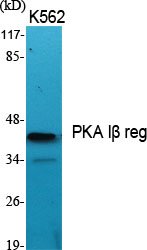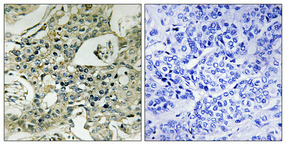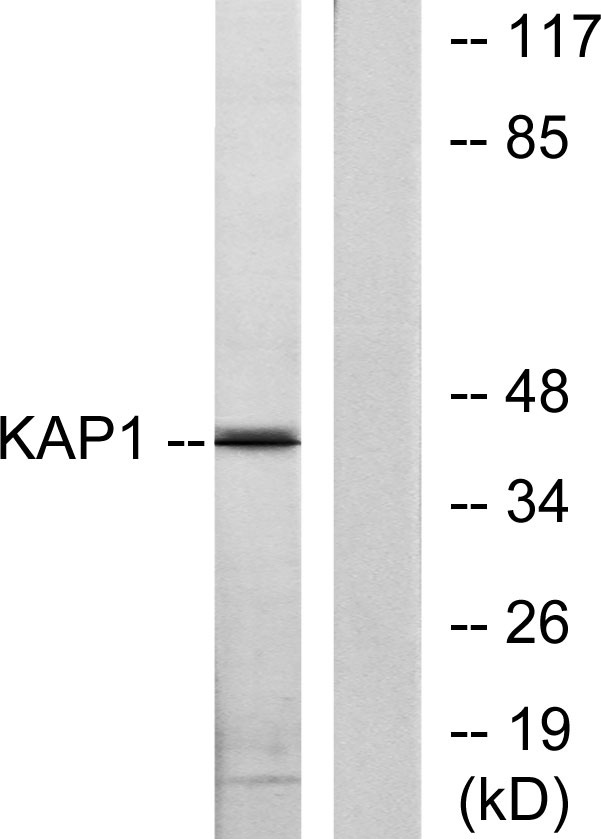PKA Iβ reg Polyclonal Antibody
- Catalog No.:YT3747
- Applications:WB;IHC;IF;ELISA
- Reactivity:Human;Mouse;Rat
- Target:
- PKA Iβ reg
- Fields:
- >>Insulin signaling pathway
- Gene Name:
- PRKAR1B
- Protein Name:
- cAMP-dependent protein kinase type I-beta regulatory subunit
- Human Gene Id:
- 5575
- Human Swiss Prot No:
- P31321
- Mouse Gene Id:
- 19085
- Mouse Swiss Prot No:
- P12849
- Rat Swiss Prot No:
- P81377
- Immunogen:
- The antiserum was produced against synthesized peptide derived from human KAP1. AA range:106-155
- Specificity:
- PKA Iβ reg Polyclonal Antibody detects endogenous levels of PKA Iβ reg protein.
- Formulation:
- Liquid in PBS containing 50% glycerol, 0.5% BSA and 0.02% sodium azide.
- Source:
- Polyclonal, Rabbit,IgG
- Dilution:
- WB 1:500 - 1:2000. IHC 1:100 - 1:300. ELISA: 1:20000.. IF 1:50-200
- Purification:
- The antibody was affinity-purified from rabbit antiserum by affinity-chromatography using epitope-specific immunogen.
- Concentration:
- 1 mg/ml
- Storage Stability:
- -15°C to -25°C/1 year(Do not lower than -25°C)
- Other Name:
- PRKAR1B;cAMP-dependent protein kinase type I-beta regulatory subunit
- Observed Band(KD):
- 43kD
- Background:
- The protein encoded by this gene is a regulatory subunit of cyclic AMP-dependent protein kinase A (PKA), which is involved in the signaling pathway of the second messenger cAMP. Two regulatory and two catalytic subunits form the PKA holoenzyme, disbands after cAMP binding. The holoenzyme is involved in many cellular events, including ion transport, metabolism, and transcription. Several transcript variants encoding the same protein have been found for this gene. [provided by RefSeq, Aug 2015],
- Function:
- PTM:The pseudophosphorylation site binds to the substrate-binding region of the catalytic chain, resulting in the inhibition of its activity.,similarity:Belongs to the cAMP-dependent kinase regulatory chain family.,similarity:Contains 2 cyclic nucleotide-binding domains.,subunit:The inactive form of the enzyme is composed of two regulatory chains and two catalytic chains. Activation by cAMP produces two active catalytic monomers and a regulatory dimer that binds four cAMP molecules.,tissue specificity:Four types of regulatory chains are found: I-alpha, I-beta, II-alpha, and II-beta. Their expression varies among tissues and is in some cases constitutive and in others inducible.,
- Subcellular Location:
- Cell membrane .
- Expression:
- Four types of regulatory chains are found: I-alpha, I-beta, II-alpha, and II-beta. Their expression varies among tissues and is in some cases constitutive and in others inducible.
- June 19-2018
- WESTERN IMMUNOBLOTTING PROTOCOL
- June 19-2018
- IMMUNOHISTOCHEMISTRY-PARAFFIN PROTOCOL
- June 19-2018
- IMMUNOFLUORESCENCE PROTOCOL
- September 08-2020
- FLOW-CYTOMEYRT-PROTOCOL
- May 20-2022
- Cell-Based ELISA│解您多样本WB检测之困扰
- July 13-2018
- CELL-BASED-ELISA-PROTOCOL-FOR-ACETYL-PROTEIN
- July 13-2018
- CELL-BASED-ELISA-PROTOCOL-FOR-PHOSPHO-PROTEIN
- July 13-2018
- Antibody-FAQs
- Products Images

- Western Blot analysis of various cells using PKA Iβ reg Polyclonal Antibody
.jpg)
- Western Blot analysis of COLO205 cells using PKA Iβ reg Polyclonal Antibody

- Immunohistochemical analysis of paraffin-embedded Human breast cancer. Antibody was diluted at 1:100(4° overnight). High-pressure and temperature Tris-EDTA,pH8.0 was used for antigen retrieval. Negetive contrl (right) obtaned from antibody was pre-absorbed by immunogen peptide.

- Western blot analysis of lysates from COLO205 cells, using KAP1 Antibody. The lane on the right is blocked with the synthesized peptide.


